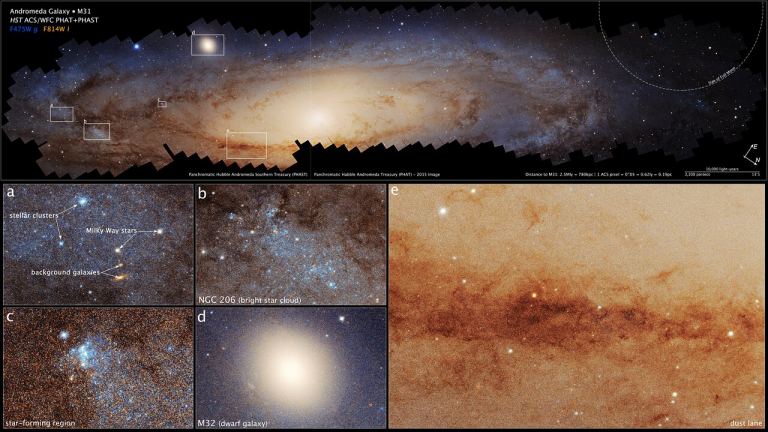The universe is vast and mysterious, but with the help of groundbreaking technology, humanity continues to peel back its layers. One such marvel of exploration is the Hubble Space Telescope’s creation of the largest photomosaic ever assembled—a breathtaking 2.5-gigapixel image of our nearest spiral galaxy, Andromeda (M31). This awe-inspiring achievement, which took over a decade to complete, offers unprecedented detail, revealing the galaxy’s structure, history, and countless secrets.
The Magnitude of the Photomosaic
Creating the Andromeda photomosaic was no small feat.
The mosaic is composed of over 600 images captured during 1,000 Hubble orbits over a decade. At 2.5 gigapixels, it is the most detailed image ever taken of a galaxy, showcasing a 48,000-light-year-wide segment of Andromeda’s disk. The image resolves approximately 200 million individual stars, offering a glimpse into the galaxy’s stellar population.

This incredible resolution was achieved through two major programs: the Panchromatic Hubble Andromeda Treasury (PHAT) and the Panchromatic Hubble Andromeda Southern Treasury (PHAST). These programs worked tirelessly to capture and analyze every detail, contributing to our understanding of Andromeda’s structure and evolutionary history.
The level of detail in this image is staggering, but it’s also essential. Unlike our view of the Milky Way, which is obscured by its internal perspective, Andromeda offers a clear, edge-on view, making it an ideal subject for studying galactic structures and dynamics.
Why Andromeda Matters
Andromeda isn’t just our closest galactic neighbor; it’s a mirror reflecting our galaxy’s past and future.
As a barred spiral galaxy similar to the Milky Way, Andromeda provides a unique opportunity to study galactic processes in a way that our own galaxy cannot. Observing Andromeda helps scientists draw parallels between the two galaxies, improving models of stellar formation, evolution, and galactic dynamics.
Ben Williams, a principal investigator at the University of Washington, emphasized the importance of Andromeda in galactic studies: “With Hubble, we can get into enormous detail about what’s happening on a holistic scale across the entire disk of the galaxy. You can’t do that with any other large galaxy.”
By studying Andromeda’s structure and stellar population, astronomers can gain insights into phenomena such as star formation rates, interstellar medium composition, and the role of dark matter in shaping galaxies.
Insights Into Galactic Evolution
The Andromeda photomosaic has revealed critical details about the galaxy’s history and structure.
Astronomers have identified a distinct difference between the galaxy’s northern and southern disks, with the latter showing more disturbances. This suggests a history of mergers and interactions with smaller galaxies, such as M32, a dwarf galaxy that may have merged with Andromeda billions of years ago.
One striking feature highlighted by the photomosaic is the Giant Southern Stream, a tidal debris field that likely originated from a past galactic collision. This stream, combined with Andromeda’s other structural features, points to a complex history of interactions that have shaped the galaxy into its current form.
Understanding these features not only provides a clearer picture of Andromeda’s past but also offers a window into how galaxies like the Milky Way evolve through mergers and collisions.
The Role of Dark Matter
Diving deeper into Andromeda’s mysteries also sheds light on the elusive dark matter.
Dark matter, which makes up a significant portion of the universe’s mass, cannot be directly observed but exerts a gravitational influence on visible matter. Andromeda’s photomosaic helps astronomers map the distribution of stars, which in turn reveals how dark matter shapes galactic structures.
Through detailed analyses of Andromeda’s stellar movements and density patterns, researchers can refine models of dark matter’s role in galaxy formation. This is particularly important as it provides clues about the fundamental forces that govern the universe.
Future Observations and Their Promise
While Hubble’s photomosaic is a monumental achievement, the journey to understand Andromeda is far from over.
The upcoming Nancy Grace Roman Space Telescope will build on Hubble’s work, offering an even broader and deeper view of Andromeda. With its wide field of view and high-resolution capabilities, the Roman telescope will capture vast areas of the galaxy in fewer exposures, making it possible to study features like the Giant Southern Stream and Andromeda’s star formation activity in greater detail.
Additionally, advancements in machine learning and artificial intelligence will enable astronomers to analyze the massive datasets generated by these observations more efficiently, unlocking new discoveries about Andromeda and other galaxies.
Lessons From Andromeda
The Andromeda photomosaic offers valuable lessons for both scientists and the public.
First, it underscores the power of collaboration and persistence in science. Over a decade of meticulous observation and analysis went into creating this image, demonstrating what humanity can achieve through dedication and innovation.
Second, it highlights the interconnectedness of the universe. By studying Andromeda, we learn more about our own Milky Way and the broader processes that shape galaxies. This reminds us that our place in the cosmos is part of a much larger and intricate story.
Conclusion
The Hubble Space Telescope’s 2.5-gigapixel photomosaic of Andromeda is more than just a stunning image; it’s a gateway to understanding the universe. From revealing the galaxy’s structural complexities to offering insights into dark matter and galactic evolution, this achievement is a testament to the boundless possibilities of exploration and discovery.
Reference:



















